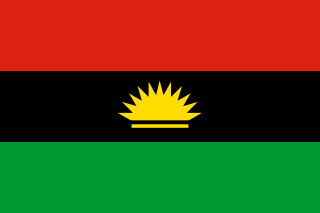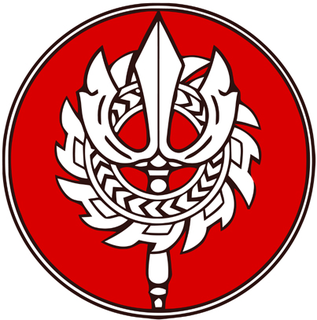 W
WThe Armed Forces of Serbia and Montenegro included ground forces with internal and border troops, naval forces, air and air defense forces, and civil defense. Preceding the VSCG was the Armed Forces of Yugoslavia from the remnants of the Yugoslav People's Army (JNA), the military of SFR Yugoslavia. The state, then named Federal Republic of Yugoslavia, participated in the Yugoslav Wars with limited direct intervention of its own armed forces. Following the end of the Wars and the constitutional reforms of 2003 by which the state was renamed "Serbia and Montenegro", the military accordingly changed its name. The military was heavily involved in combating Albanian separatists during the Kosovo War and Preševo Valley conflict, and also engaged NATO airplanes during the 1999 NATO bombing of Yugoslavia.
 W
WThe Biafran Armed Forces (BAF) were the military of the secessionist state of Biafra which existed from 1967 until 1970.
 W
WThe Bophuthatswana Defence Force was established on 6 December 1977 from trainees of the South African Defence Force. It was the defence force of the Republic of Bophuthatswana, a nominally independent bantustan during the Apartheid era of South Africa.
 W
WThe Khmer National Armed Forces were the official armed defense forces of the Khmer Republic, a short-lived state that existed from 1970 to 1975, known today as Cambodia. The FANK was the successor of the Royal Khmer Armed Forces which had been responsible for the defense of the previous Kingdom of Cambodia since its independence in 1954 from France.
 W
WThe Ciskei Defence Force (CDF) was established during March 1981 from the 141 Battalion of the South African Defence Force (SADF). It was the defence force of Ciskei, a bantustan that was controlled by the apartheid regime of South Africa. The CDF functioned as part of the 21 Battalion based near Lenasia, outside Johannesburg.
 W
WThe term Collaborationist Chinese Army refers to the military forces of the puppet governments founded by Imperial Japan in mainland China during the Second Sino-Japanese War and World War II. They include the armies of the Provisional (1937–1940), Reformed (1938–1940) and Reorganized National Governments of the Republic of China (1940–1945), which absorbed the former two regimes.
 W
WThe Kampuchea People's Revolutionary Armed Forces (KPRAF), also the Khmer People's Revolutionary Armed Forces were the armed forces of the People's Republic of Kampuchea, the de facto government of Cambodia 1979–1990. It was formed with military assistance from Vietnam, which furbished the fledgling armed forces with equipment and training, with the initial task of countering the sustained guerrilla campaign being waged by the Coalition Government of Democratic Kampuchea.
 W
WThe Royal Lao Armed Forces, best known by its French acronym FAR, were the official armed defense forces of the Kingdom of Laos, a state that existed from 1949 to 1975 in what is now the Lao People's Democratic Republic. The FAR was responsible for the defense of the Kingdom since its independence in October 1953 from France.
 W
WThe military of the Polish–Lithuanian Commonwealth consisted of two administratively separate armies of the Kingdom of Poland and the Grand Duchy of Lithuania following the 1569 Union of Lublin, which joined to form the bi-conderate elective monarchy of the Polish–Lithuanian Commonwealth. The army of each country was commanded by their respective Hetmans. The most unique formation of both armies were the Winged hussars. The Polish–Lithuanian Commonwealth Navy never played a major role and ceased to exist in the mid-17th century.
 W
WThe National People's Army were the armed forces of the German Democratic Republic (GDR) from 1956 to 1990.
 W
WThe Rhodesian Security Forces were the military forces of the Rhodesian government. The Rhodesian Security Forces consisted of a ground force, the Rhodesian Air Force, the British South Africa Police, and various personnel affiliated to the Rhodesian Ministry of Internal Affairs. Despite the impact of economic and diplomatic sanctions, Rhodesia was able to develop and maintain a potent and professional military capability.
 W
WThe Royal Armed Forces were the armed forces of the Burmese monarchy from the 9th to 19th centuries. It refers to the military forces of the Pagan Dynasty, the Ava Kingdom, the Toungoo Dynasty and the Konbaung Dynasty in chronological order. The army was one of the major armed forces of Southeast Asia until it was defeated by the British over a six-decade span in the 19th century.
 W
WRoyal Guards were an elite military formation and regiment of the Kingdom of Poland and the Polish–Lithuanian Commonwealth directly responsible for the protection of the monarch and his family.
 W
WThe South African Defence Force (SADF) comprised the South African armed forces from 1957 until 1994. Shortly before the state reconstituted itself as a republic in 1961, the former Union Defence Force was officially succeeded by the SADF, which was established by the Defence Act of 1957. The SADF, in turn, was superseded by the South African National Defence Force in 1994.
 W
WThe Spanish Republican Armed Forces were initially formed by the following two branches of the military of the Second Spanish Republic:Spanish Republican Army. It included the Aeronáutica Militar air arm. Spanish Republican Navy, which included the naval aviation.
 W
WThe Transkei Defence Force (TDF) was established during March 1981, from the 141 Battalion of the South African Defence Force (SADF). It was the defence force of the Republic of Transkei, a nominally independent bantustan during the Apartheid era of South Africa.
 W
WThe Venda Defence Force (VDF) was established in September 1982 from the 112 Battalion of the South African Defence Force and the military branch of the Venda National Force which itself had been formed when the Venda homeland became independent from South Africa in September 1979.
 W
WThe Republic of Vietnam Military Forces, were the official armed defense forces of the defunct Republic of Vietnam and was responsible for the defense of the state since its independence from France in July 1954 to its demise in April 1975.
 W
WThe Wehrmacht was the unified armed forces of Nazi Germany from 1935 to 1945. It consisted of the Heer (army), the Kriegsmarine (navy) and the Luftwaffe. The designation "Wehrmacht" replaced the previously-used term Reichswehr, and was the manifestation of the Nazi regime's efforts to rearm Germany to a greater extent than the Treaty of Versailles permitted.